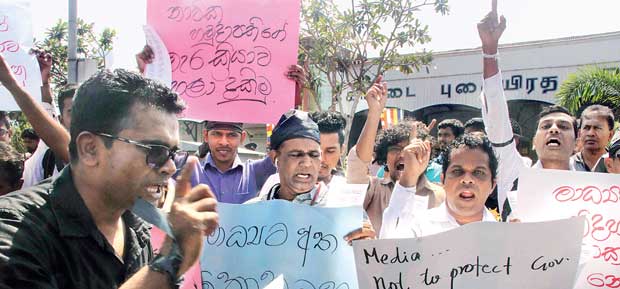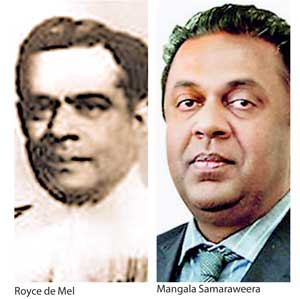Reply To:
Name - Reply Comment
Last Updated : 2024-04-25 20:04:00

 In 1959, Prime Minister SWRD Bandaranaike appointed hand-picked, Aleric Abeykoon and in 1955 Sir John Kotalawala appointed Royce de Mel, as IGP and Navy Commander respectively, to head the two institutions and Sirimavo paid the penalty in the early 1960s. Royce de Mel abused his authority by smuggling in contraband in naval vessels and was interdicted. The disgruntled man, Rear Admiral De Mel conspired with a few military men to topple Sirimavo’s Government in 1962. The clueless IGP continued playing bridge at his famous club even after being warned of the coup that was to be staged in a few hours.
In 1959, Prime Minister SWRD Bandaranaike appointed hand-picked, Aleric Abeykoon and in 1955 Sir John Kotalawala appointed Royce de Mel, as IGP and Navy Commander respectively, to head the two institutions and Sirimavo paid the penalty in the early 1960s. Royce de Mel abused his authority by smuggling in contraband in naval vessels and was interdicted. The disgruntled man, Rear Admiral De Mel conspired with a few military men to topple Sirimavo’s Government in 1962. The clueless IGP continued playing bridge at his famous club even after being warned of the coup that was to be staged in a few hours.
 It would be interesting to look at two contrasting views expressed by two former highly respected senior DIGs on the Prime Minister SWRD’s decision to bring in a stranger, M. W. F. Abeykoon from the Ceylon Civil Service to head the Police Department, overlooking several seniors in the service. Senior DIG (Retd) Gamini Gunawardene speaking to the Sunday Times states-
It would be interesting to look at two contrasting views expressed by two former highly respected senior DIGs on the Prime Minister SWRD’s decision to bring in a stranger, M. W. F. Abeykoon from the Ceylon Civil Service to head the Police Department, overlooking several seniors in the service. Senior DIG (Retd) Gamini Gunawardene speaking to the Sunday Times states-
“Prime Minister SWRD picked as his new IGP a civil servant who was a Buddhist; M W F Abeykoon... Senior officers met in conference to decide what to do. They considered the first option: the entire Executive Corps should resign en masse… next day they surveyed the executive corps for the senior most officer among them who was a Buddhist…they could find only young SP Stanley Senanayake. They resolved to make representations to the Prime Minister that they were prepared to work under Stanley who was junior to all of them rather than having to work under an outsider with no experience who knew nothing of Police or Police Ordinance.”— Sunday Times, Plus; 28/11/2010
In contrast, Senior DIG (Retd), Edward Gunawardene, writing to the same newspaper, the Sunday Times of April 30, 2006, says,
“The IGP Osmund de Silva had retired and a serious crisis had developed with brothers C. C. Dissanayake and S. A. Dissanayake; and Sydney de Zoysa, all DIGs with equal seniority hotly contending for the plum. SWRD Bandaranaike, the shrewd Prime Minister seized this opportunity gifted by the internecine conflict… to appoint a man of his choice.” —Sunday Times, Plus; 30/04/06
Some political analysts have attempted to point a finger at Prime Minister Bandaranaike on this issue criticizing his action as the beginning of the politicization of the Police service. Unfortunately, the precedence was created by the rulers in 1947, when they brought in outsider Sir Richard Aluvihare, a member of Ceylon Civil Service, who at the time was serving in the Treasury as a Senior Administrator, to the position of Inspector General of Police, who ran the department efficiently unlike Bandaranike’s choice.
As an outsider, a man who had never worn a uniform, M. W. F. Abeykoon was parachuted and made the 14th IGP of Ceylon. He served from April 26, 1959 to April 29, 1963, under both Bandaranaikes. The PMs knew they had blundered badly and Abeykoon would only be a puppet and the Police would be akin to a ship minus a rudder.
Two of his DIGs [out of six] conspired to stage a Coup d’état during his tenure. In so far as we are aware, the system that was introduced and prevailed till the late S. W. R. D. Bandaranaike took over as the Prime Minister of Ceylon(now Sri Lanka), was to have the next most Senior Officer appointed as the Inspector General of Police, when a vacancy occurred.
Mr. Abeykoon was playing bridge at The Orient Club, while his subordinates were planning a Coup d’état!
Royce de Mel as Navy Commander
There were six of them, the famous de Mel brothers, who turned a new leaf in the history of St Joseph’s College. Out of the six, Royce was the eldest, who excelled in athletics. He joined the Royal Navy, and progressed to reach the top as the first Lankan Commander of the Navy. He was appointed on 15 August 1955. De Mel was promoted to Rear Admiral in 1959, becoming the first serving officer to hold the rank. The Ceylon Navy was launched on 9th of December 1950, under the Ceylon Navy Act, replacing the British Royal Ceylon Navy with the English commander, W E Banks retained as Captain (chief), until the return of Commander Royce de Mel, who was in the UK, under training. His brother was Maurice, a sportsman himself, who rose to the rank of Colonel and subsequently promoted to Chief of Staff, or the second-in-command of the Army by 1960. The two brothers were charged with conspiring to topple the government in 1962 and was placed sixth and second defendants in the Coup trial, Queen vs Liyanage.
“Royce de Mel was very fatalistic about the consequences to him of his involvement in the coup. As a devout Roman Catholic he believed that God wanted to punish him by making him go to jail. He conceded that in many countries coup leaders like him would have been placed against a wall and shot” -JRJ Biography: K M de Silva/Howard Wriggins;-Pp 119
The new government that Bandaranaike established in 1956 decided to take over, as part of its programme in freeing the nation of every little hold of the colonial masters, preferred to have the Navy and Air Force under its arm. The British Government was informed accordingly. On October 15, 1957, the naval base was nationalized at a ceremony attended by SWRD Bandaranaike, the then Prime Minister, marking a significant milestone in the path to gaining complete independence. Sri Lanka Navy thereafter took over the administration using Trincomalee as the key naval base, a progressive step disliked by many officer cadres.
Royce de Mel had been ‘captain’ (as the commander was known then), until 1961, when he was sent on compulsory retirement following a revelation in a report submitted by a committee that investigated irregularities in the Navy. They found him guilty of smuggling contraband on a naval craft. Royce de Mel was the only suspect in the 1962 coup who went underground to evade arrest. However, at the commencement of the trial he surrendered to Trial at Bar through his lawyer, G. G. Ponnambalam QC.
Extract from, Blueprint to Bluewater-- The Indian Navy, 1951-65
‘…We paid a good will visit to Colombo in 1962. We had a few Ceylonese cadets on board and I used the opportunity to hold meetings with Ceylonese Sri Lankan Naval Headquarters and the Defence Ministry to sort out some administrative problems these cadets were experiencing.
Shortly after we left Colombo a local newspaper published a report saying that the real purpose our visit was to smuggle former Rear Admiral Royce de Mel, ex Chief of Navy, out of the country.
Admiral had been sacked an year earlier for alleged involvement in a local scandal.’ By Satyindra Singh: pp- 508
The above attempt was thwarted by alert security men who knew about de Mel’s close contact with his Indian naval friends. He was under warrants and was evading arrest. When CBK’s Security men led an attack on media on July 15, 1999, journalists covering the march organized by the UNP were brutally attacked with batons, tear gas, rubber bullets and high-pressure water cannons. The attackers, PSD men uniformed and in civil clothes snatched cameras from most of the journalists, destroyed some of them on the spot and seized those of some others. When the club-wielding policemen and thugs [Beddagane Sanjeewa, a well known criminal was absorbed into the PSD of CBK] were harshly assaulting the journalists, uniformed policemen were abusing the journalists. Sunday Times photographer, Athula Devapriya, was assaulted and arrested. His film was taken out and exposed.
It was a well-planned and well-targeted attack. 10 journalists were injured seriously out of about 25 injured, most of them had to be hospitalized.
Journalists who were assaulted recognized the police officers and constables connected with the PSD. Ravaya newspaper carried photos of the two policemen—SI Thusara Perera, and constable Saliya of the PSD—clearly screening their involvement in the attack. The UNP demonstrators were also beaten and dispersed. They abandoned their plan to march. Several UNP leaders, including former ministers were injured and had to be hospitalized. The UNP marched to protest the failure of the People’s Alliance government of CBK to fulfil its election pledges; especially the promise to abolish the Executive Presidency. Today the UNP is back in power, ironically they too do not fulfil promises, but attack demonstrators.
Politics and Media freedom
Just the day before the attack, the Media Minister, Mangala Samaraweera issued a press release critical of the media who exposed corruption in the PA Government, and prepared the climate for the attack the following day. President Kumaratunga described them as “Media Mafia”. The statement said, people should endeavour to “save the free media from the Media Mafia which is taking undue advantage of the free media culture established by the PA Government”.
The next day, the same Minister blamed the demonstrators, the UNP. DIG, T.N. de Silva, who was in charge of the police team deployed at the venue on July 15, told reporters that PSD officers were not involved in the assault and “neither I nor any other police officers had seen anyone being assaulted”.
However, Saman Mendis, a photographer attached to government-owned Lake House, contradicted the Media Minister and confirmed saying, “When I was about to be assaulted, realizing that the attackers are mobilized by the regime, I shouted ‘I am from the Lake House’.” But they did not shoot indiscriminately like in Wathupitiwela.
A combined force of journalist held a protest march to Temple Trees a week later. A police battalion kept watch about 100 meters away. At that point the journalist demonstrators burned the effigies of Media Minister Mangala Samaraweera and the chief of the PSD, ASP Nihal Karunaratna.
“The only security of all
is in a free press.”
― Thomas Jefferson

Add comment
Comments will be edited (grammar, spelling and slang) and authorized at the discretion of Daily Mirror online. The website also has the right not to publish selected comments.
Reply To:
Name - Reply Comment
US authorities are currently reviewing the manifest of every cargo aboard MV
On March 26, a couple arriving from Thailand was arrested with 88 live animal
According to villagers from Naula-Moragolla out of 105 families 80 can afford
Is the situation in Sri Lanka so grim that locals harbour hope that they coul